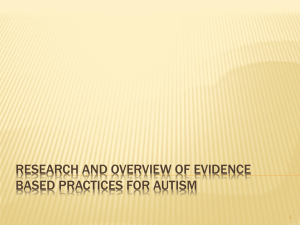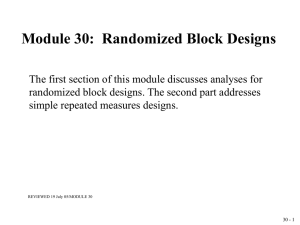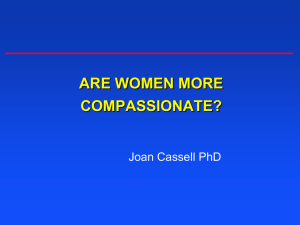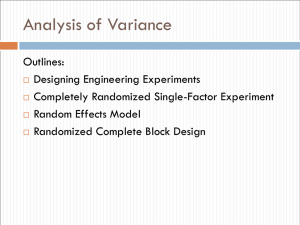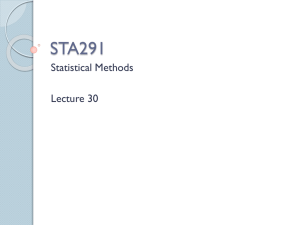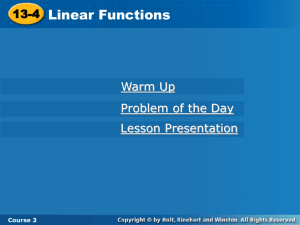ch13
advertisement
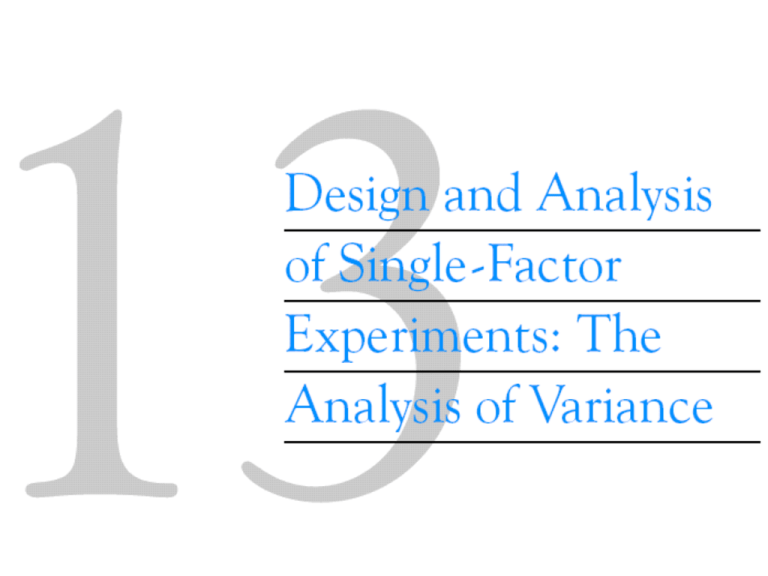
13-1 Designing Engineering Experiments Every experiment involves a sequence of activities: 1. Conjecture – the original hypothesis that motivates the experiment. 2. Experiment – the test performed to investigate the conjecture. 3. Analysis – the statistical analysis of the data from the experiment. 4. Conclusion – what has been learned about the original conjecture from the experiment. Often the experiment will lead to a revised conjecture, and a new experiment, and so forth. 13-2 The Completely Randomized SingleFactor Experiment 13-2.1 An Example 13-2 The Completely Randomized SingleFactor Experiment 13-2.1 An Example 13-2 The Completely Randomized SingleFactor Experiment 13-2.1 An Example • The levels of the factor are sometimes called treatments. • Each treatment has six observations or replicates. • The runs are run in random order. 13-2 The Completely Randomized SingleFactor Experiment 13-2.1 An Example Figure 13-1 (a) Box plots of hardwood concentration data. (b) Display of the model in Equation 13-1 for the completely randomized single-factor experiment 13-2 The Completely Randomized SingleFactor Experiment 13-2.2 The Analysis of Variance Suppose there are a different levels of a single factor that we wish to compare. The levels are sometimes called treatments. 13-2 The Completely Randomized SingleFactor Experiment 13-2.2 The Analysis of Variance We may describe the observations in Table 13-2 by the linear statistical model: The model could be written as 13-2 The Completely Randomized SingleFactor Experiment 13-2.2 The Analysis of Variance Fixed-effects Model The treatment effects are usually defined as deviations from the overall mean so that: Also, 13-2 The Completely Randomized SingleFactor Experiment 13-2.2 The Analysis of Variance We wish to test the hypotheses: The analysis of variance partitions the total variability into two parts. 13-2 The Completely Randomized SingleFactor Experiment 13-2.2 The Analysis of Variance Definition 13-2 The Completely Randomized SingleFactor Experiment 13-2.2 The Analysis of Variance The ratio MSTreatments = SSTreatments/(a – 1) is called the mean square for treatments. 13-2 The Completely Randomized SingleFactor Experiment 13-2.2 The Analysis of Variance The appropriate test statistic is We would reject H0 if f0 > f,a-1,a(n-1) 13-2 The Completely Randomized SingleFactor Experiment 13-2.2 The Analysis of Variance Definition 13-2 The Completely Randomized SingleFactor Experiment 13-2.2 The Analysis of Variance Analysis of Variance Table 13-2 The Completely Randomized SingleFactor Experiment Example 13-1 13-2 The Completely Randomized SingleFactor Experiment Example 13-1 13-2 The Completely Randomized SingleFactor Experiment Example 13-1 13-2 The Completely Randomized SingleFactor Experiment Definition For 20% hardwood, the resulting confidence interval on the mean is 13-2 The Completely Randomized SingleFactor Experiment Definition For the hardwood concentration example, 13-2 The Completely Randomized SingleFactor Experiment An Unbalanced Experiment 13-2 The Completely Randomized SingleFactor Experiment 13-2.3 Multiple Comparisons Following the ANOVA The least significant difference (LSD) is If the sample sizes are different in each treatment: 13-2 The Completely Randomized SingleFactor Experiment Example 13-2 13-2 The Completely Randomized SingleFactor Experiment Example 13-2 13-2 The Completely Randomized SingleFactor Experiment Example 13-2 Figure 13-2 Results of Fisher’s LSD method in Example 13-2 13-2 The Completely Randomized SingleFactor Experiment 13-2.5 Residual Analysis and Model Checking 13-2 The Completely Randomized SingleFactor Experiment 13-2.5 Residual Analysis and Model Checking Figure 13-3 Normal probability plot of residuals from the hardwood concentration experiment. 13-2 The Completely Randomized SingleFactor Experiment 13-2.5 Residual Analysis and Model Checking Figure 13-4 Plot of residuals versus factor levels (hardwood concentration). 13-2 The Completely Randomized SingleFactor Experiment 13-2.5 Residual Analysis and Model Checking Figure 13-5 Plot of residuals versus yi 13-3 The Random-Effects Model 13-3.1 Fixed versus Random Factors 13-3 The Random-Effects Model 13-3.2 ANOVA and Variance Components The linear statistical model is The variance of the response is Where each term on the right hand side is called a variance component. 13-3 The Random-Effects Model 13-3.2 ANOVA and Variance Components For a random-effects model, the appropriate hypotheses to test are: The ANOVA decomposition of total variability is still valid: 13-3 The Random-Effects Model 13-3.2 ANOVA and Variance Components The expected values of the mean squares are 13-3 The Random-Effects Model 13-3.2 ANOVA and Variance Components The estimators of the variance components are 13-3 The Random-Effects Model Example 13-4 13-3 The Random-Effects Model Example 13-4 13-3 The Random-Effects Model Figure 13-7 The distribution of fabric strength. (a) Current process, (b) improved process. 13-4 Randomized Complete Block Designs 13-4.1 Design and Statistical Analyses The randomized block design is an extension of the paired t-test to situations where the factor of interest has more than two levels. Figure 13-8 A randomized complete block design. 13-4 Randomized Complete Block Designs 13-4.1 Design and Statistical Analyses For example, consider the situation of Example 10-9, where two different methods were used to predict the shear strength of steel plate girders. Say we use four girders as the experimental units. 13-4 Randomized Complete Block Designs 13-4.1 Design and Statistical Analyses General procedure for a randomized complete block design: 13-4 Randomized Complete Block Designs 13-4.1 Design and Statistical Analyses The appropriate linear statistical model: We assume • treatments and blocks are initially fixed effects • blocks do not interact • 13-4 Randomized Complete Block Designs 13-4.1 Design and Statistical Analyses We are interested in testing: 13-4 Randomized Complete Block Designs 13-4.1 Design and Statistical Analyses The mean squares are: 13-4 Randomized Complete Block Designs 13-4.1 Design and Statistical Analyses The expected values of these mean squares are: 13-4 Randomized Complete Block Designs 13-4.1 Design and Statistical Analyses Definition 13-4 Randomized Complete Block Designs 13-4.1 Design and Statistical Analyses 13-4 Randomized Complete Block Designs Example 13-5 13-4 Randomized Complete Block Designs Example 13-5 13-4 Randomized Complete Block Designs Example 13-5 13-4 Randomized Complete Block Designs Example 13-5 Minitab Output for Example 13-5 13-4 Randomized Complete Block Designs Minitab Output for Example 13-5 13-4 Randomized Complete Block Designs 13-4.2 Multiple Comparisons Fisher’s Least Significant Difference for Example 13-5 Figure 13-9 Results of Fisher’s LSD method. 13-4 Randomized Complete Block Designs 13-4.3 Residual Analysis and Model Checking Figure 13-10 Normal probability plot of residuals from the randomized complete block design. 13-4 Randomized Complete Block Designs Figure 13-11 Residuals by treatment. 13-4 Randomized Complete Block Designs Figure 13-12 Residuals by block. 13-4 Randomized Complete Block Designs Figure 13-13 Residuals versus ŷij.
